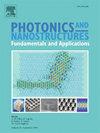基于全息图设计和反馈回路的飞秒激光多光束自适应调制
IF 2.9
3区 物理与天体物理
Q3 MATERIALS SCIENCE, MULTIDISCIPLINARY
Photonics and Nanostructures-Fundamentals and Applications
Pub Date : 2025-08-07
DOI:10.1016/j.photonics.2025.101433
引用次数: 0
摘要
飞秒激光器在微纳加工中具有独特的优势,在精密制造中得到了广泛的应用。然而,单光束固有的高斯强度分布从根本上限制了处理效率,而多光束方法由于相位畸变和光学像差而存在能量不均匀性。为了解决这些问题,本研究提出了一种基于全息图设计(通过优化叠加全息图的权重)和实时反馈回路(动态纠正光源变形和硬件缺陷对光束质量的影响)的多光束能量均匀性增强方法。实验结果清楚地表明,该方法成功地实现了均匀的四波束调制,使处理速度提高了四倍。仅采用本文提出的全息图设计方法时,四束光的均匀度系数为0.831,四束光强比的标准差为2.3 %。当全息图设计与反馈回路校正相结合时,均匀系数提高到0.965,标准差降低到0.4 %。在实际加工中,烧蚀宽度均匀性达到6.10 ± 0.426 μm。该方法既提高了加工效率,又提高了加工质量,为飞秒激光加工的应用提供了新的技术途径。本文章由计算机程序翻译,如有差异,请以英文原文为准。
Adaptive modulation of femtosecond laser multi-beams based on hologram design and feedback loop
Femtosecond lasers demonstrate unique advantages in micro/nano processing and are widely used in precision manufacturing. However, the inherent Gaussian intensity distribution of single-beam fundamentally limits processing efficiency, while multi-beam approaches suffer from energy non-uniformity due to phase distortions and optical aberrations. To address these challenges, this study proposes a multi-beam energy uniformity enhancement method based on hologram design (by optimizing the weighting of superimposed holograms) and real-time feedback loop (dynamically correcting the impact of light source deformation and hardware defects on beam quality). Experimental findings clearly show the proposed approach successfully accomplishes uniform four-beam modulation, enabling a four-times increase in processing speed. When only the proposed hologram design method is used, the uniformity factor of four beam is 0.831, and the standard deviation of the intensity ratio of four beams is 2.3 %. When the hologram design is combined with the correction of the feedback loop, the uniformity factor increases to 0.965 and the standard deviation is reduced to 0.4 %. In actual processing, the uniformity of the ablation width reaches 6.10 ± 0.426 μm. The proposed method can both improve the processing efficiency and enhance the processing quality, which provides a new technological approach for the application of femtosecond laser processing.
求助全文
通过发布文献求助,成功后即可免费获取论文全文。
去求助
来源期刊
CiteScore
5.00
自引率
3.70%
发文量
77
审稿时长
62 days
期刊介绍:
This journal establishes a dedicated channel for physicists, material scientists, chemists, engineers and computer scientists who are interested in photonics and nanostructures, and especially in research related to photonic crystals, photonic band gaps and metamaterials. The Journal sheds light on the latest developments in this growing field of science that will see the emergence of faster telecommunications and ultimately computers that use light instead of electrons to connect components.

 求助内容:
求助内容: 应助结果提醒方式:
应助结果提醒方式:


